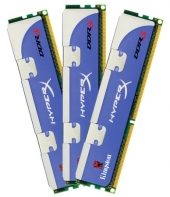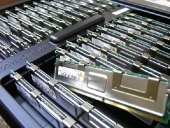RAM
RAM, short for Random Access Memory, is the “short-term memory” of the computer. It holds whatever the processor is currently working on so that it is readily available. The term paper you’re typing up, the internet browser full of research material, the music playing off of your playlist, and your internet chat conversation are all held in RAM. The more you have, the more the system can handle at once; and the faster the RAM runs, the faster it can swap to doing something else. But there are limits to everything.
Windows Vista won’t run very well on less than 2GB of RAM, but you won’t see much improvement past 4GB. In fact, 32-bit operating systems (which it is by default unless it says otherwise) can’t handle more than 4GB of RAM at all. If you go with a 64-bit operating system, it can handle up to 16GB of RAM – but the average home user isn’t going to need that much. Even gamers won’t find much of a need for more than 8GB. For the average person, 4GB of RAM is a sweet spot these days.
RAM also has a bus speed, measured in MHz. This rating has to match the front side bus of the processor and the motherborad, or else the lowest value is used (also known as a “bottleneck”, named for where it’s thinnest).
Hard drives
The hard drive is the long-term memory of the computer, holding the operating system, your pictures, games, and movies. Storage is getting cheaper and cheaper these days. It’s easy to find a 2TB (terabyte) drive for under $100, which is enough to hold more than 3,000 hours of video. However, if you want to compare performance of drives, you have to look at the RPM, cache, and bus speeds.
The RPM designates how fast the drive spins – inside of it there are platters that look like records (complete with reading needle). The faster the platters spin, the faster the data can be accessed. Bargin drives run at 5400RPM, while most standard drives run at 7200RPM. Performance drives run at 10,000RPM or higher, and are noticably faster than other speeds. Even faster are SSD, or Solid State Drives. They don’t have any spinning platters, and are like oversized USB thumb drives. They have no moving parts and their data can be accessed incredibly quickly. However, SSD drives are generally smaller and more expensive than their traditional counterparts. If you’re looking to use a SSD hard drive for performance, you’re better off using it on the operating system drive and then using a traditional drive for your media storage needs.
The cache on a drive is similar to the cache on a processor: It’s a bank of memory that stores data for other use. A cache helps a drive find data faster by storing the most-often-needed information where it can be accessed without having to move the reading arm to that part of the disk. A larger cache is better, but most are under 100MB.
Bus speeds on hard drives are also pretty standard. Hard drives have been running on an interface called SATA for awhile now, and you just have to make sure that the SATA version matches what the motherboard is capable of (maxing out at SATA-3 at the time of writing). if the motherboard and hard drive SATA don’t match, it will run at the lower version’s speed.



[…] Building Computers for the Weekend Geek @ TechwareLabs .:. ADATA HM Series 1200W Power Supply Review @ Kitguru .:. AMD Mecha HK-2207 Demo 1.2 @ NGOHQ .:. Thermaltake ARMOR A30 @ TechREACTION .:. NVIDIA Interview: Tegra 2 and Project Denver – March 31, 2011 @ Hi Tech Legion .:. Tt eSports Azurues Gaming Mouse Review @ eTeknix […]